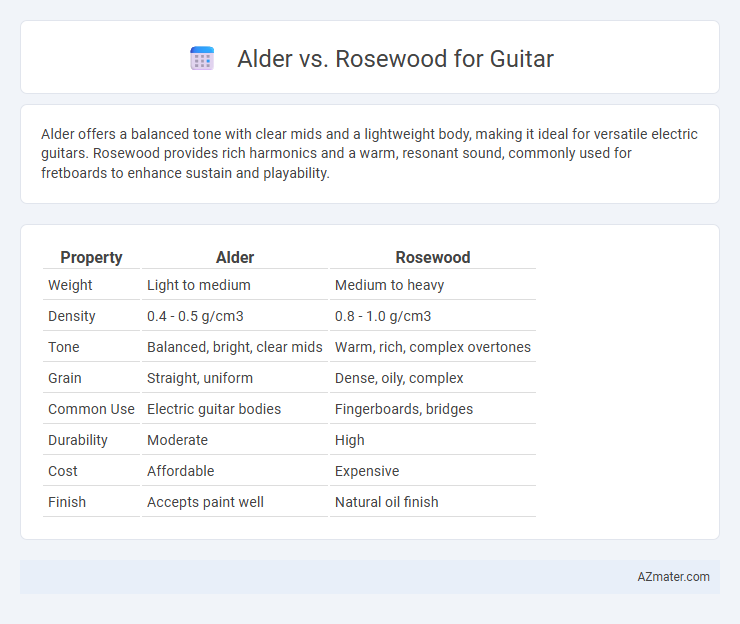Alder offers a balanced tone with clear mids and a lightweight body, making it ideal for versatile electric guitars. Rosewood provides rich harmonics and a warm, resonant sound, commonly used for fretboards to enhance sustain and playability.
Table of Comparison
| Property | Alder | Rosewood |
|---|---|---|
| Weight | Light to medium | Medium to heavy |
| Density | 0.4 - 0.5 g/cm3 | 0.8 - 1.0 g/cm3 |
| Tone | Balanced, bright, clear mids | Warm, rich, complex overtones |
| Grain | Straight, uniform | Dense, oily, complex |
| Common Use | Electric guitar bodies | Fingerboards, bridges |
| Durability | Moderate | High |
| Cost | Affordable | Expensive |
| Finish | Accepts paint well | Natural oil finish |
Introduction: Alder vs Rosewood for Guitar
Alder and rosewood are popular tonewoods used in guitar construction, each offering distinct sonic characteristics and physical properties. Alder provides a balanced, full-bodied sound with pronounced midrange and clear highs, making it ideal for versatile playing styles. Rosewood, often used for fretboards and backs, delivers rich overtones, smooth sustain, and a warm, resonant tone favored in both acoustic and electric guitars.
Overview of Tonewoods in Guitar Construction
Alder and rosewood are prominent tonewoods in guitar construction, each influencing sound and resonance differently. Alder is prized for its balanced midrange and clear, full-bodied tone, often used in electric guitar bodies for a bright yet warm sound. Rosewood is favored for fingerboards due to its dense, oily texture, enhancing sustain and providing a rich, complex tonal character with pronounced lows and sparkling highs.
Physical Properties of Alder and Rosewood
Alder wood is known for its lightweight density, averaging around 0.4 to 0.6 g/cm3, which provides a balanced resonance and bright, clear tonality in guitars. Rosewood, with a higher density ranging from 0.8 to 1.0 g/cm3, offers greater hardness and durability, contributing to enhanced sustain and richer overtones. The porous nature of alder allows for efficient vibration transfer, while rosewood's oily texture resists moisture and adds warmth to the instrument's sound profile.
Tonal Characteristics: Alder vs Rosewood
Alder wood offers a balanced tonal profile with clear mids, strong attack, and a bright, full-bodied sound ideal for versatile guitar styles. Rosewood produces warm tones with rich overtones, pronounced bass, and a smooth sustain, favored for its depth and complexity in fingerstyle and jazz guitars. The tonal contrast between alder's clarity and rosewood's warmth significantly influences guitar resonance and overall sound character.
Weight and Comfort: Playability Differences
Alder is lighter than rosewood, making guitars more comfortable for extended playing sessions due to reduced fatigue. Rosewood tends to be denser and heavier, which can add substantial weight to the guitar body, potentially causing discomfort during long performances. The lighter alder body enhances overall playability by allowing easier mobility and better balance, whereas rosewood's weight contributes to a solid feel but may reduce comfort for some players.
Durability and Maintenance Comparison
Alder offers moderate durability with a lightweight structure that resists cracking and warping, making it easier to maintain over time with minimal upkeep. Rosewood is denser and heavier, providing superior resistance to scratches and dings but requires regular oiling to prevent drying and cracking. Both woods exhibit strong longevity, but rosewood's maintenance needs are higher due to its natural oils and tighter grain structure.
Impact on Electric Guitars: Alder vs Rosewood
Alder is widely favored for electric guitar bodies due to its balanced tone, offering clear mids and a full-range sound that enhances pickups' clarity and resonance. Rosewood, primarily used for fingerboards rather than bodies, contributes to warmer tones with rich overtones and smooth sustain, influencing playability and tonal expression. The combination of alder bodies with rosewood fingerboards remains popular for achieving a versatile sound that appeals to various playing styles.
Influence on Acoustic Guitars: Sound Projection and Warmth
Alder wood is less commonly used in acoustic guitars but offers a balanced tone with clear midrange and moderate warmth, resulting in less pronounced sound projection compared to rosewood. Rosewood, favored in acoustic guitar backs and sides, enhances sound projection through its dense grain, producing rich overtones and deep, warm bass response. The tonal depth and resonance of rosewood significantly contribute to the overall warmth and sustain in acoustic guitars, making it a popular choice for premium acoustic instruments.
Price and Availability of Alder and Rosewood
Alder is widely available and generally more affordable than rosewood, making it a popular choice for many guitar manufacturers. Rosewood, prized for its rich tonal qualities and aesthetic appeal, tends to be more expensive due to its limited availability and stricter export regulations. Budget-conscious players often opt for alder bodies, while premium models frequently feature rosewood fingerboards despite the higher cost.
Choosing the Right Tonewood: Alder or Rosewood?
Choosing the right tonewood significantly influences a guitar's sound and playability, with alder and rosewood offering distinct tonal characteristics. Alder delivers a balanced, clear, and full-bodied sound with strong midrange and excellent sustain, making it ideal for versatile playing styles. Rosewood, known for its rich, warm, and complex overtones, enhances bass response and adds resonance, preferred by players seeking depth and a vintage vibe in their guitar tone.

Infographic: Alder vs Rosewood for Guitar
 azmater.com
azmater.com